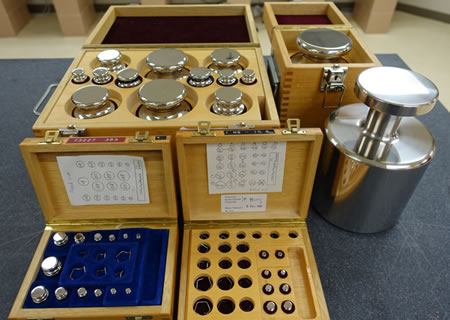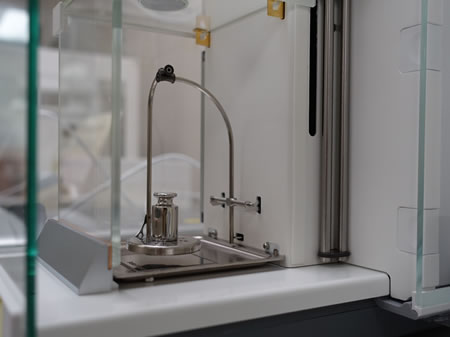Calibration Services
Mass and Related Quantities: Mass Measurements
General
The Mass and related quantities Laboratory of SCL provide calibration services for standard weights of accuracy class E2 and lower in the range from 1mg to 10kg, and standard weights of accuracy class F1 and lower from 20kg to 50kg. The classification of weights depends on their maximum permissible measurement errors (refer to the following table), shape, material, construction and surface finish, as described in the International Recommendation R111 - (Metrological and technical requirements for weights of classes E1, E2, F1, F2, M1, M2, M3) of the International Organization of Legal Metrology (OIML).
| Nominal Values of Mass | Accuracy Class E2 (±mg) |
Accuracy Class F1 (±mg) |
Accuracy Class F2 (±mg) |
Accuracy Class M1 (±mg) |
Accuracy Class M2 (±mg) |
Accuracy Class M3 (±mg) |
|---|---|---|---|---|---|---|
| 50kg | 80 | 250 | 800 | 2500 | 8000 | 25000 |
| 20kg | 30 | 100 | 300 | 1000 | 3000 | 10000 |
| 10kg | 16 | 50 | 160 | 500 | 160 | 5000 |
| 5kg | 8.0 | 25 | 80 | 250 | 800 | 2500 |
| 2kg | 3.0 | 10 | 30 | 100 | 300 | 1000 |
| 1kg | 1.6 | 5.0 | 16 | 50 | 160 | 500 |
| 500g | 0.8 | 2.5 | 8.0 | 25 | 80 | 250 |
| 200g | 0.3 | 1.0 | 3.0 | 10 | 30 | 100 |
| 100g | 0.16 | 0.5 | 1.6 | 5.0 | 16 | 50 |
| 50g | 0.10 | 0.3 | 1.0 | 3.0 | 10 | 30 |
| 20g | 0.08 | 0.25 | 0.8 | 2.5 | 8.0 | 25 |
| 10g | 0.06 | 0.20 | 0.6 | 2.0 | 6.0 | 20 |
| 5g | 0.05 | 0.16 | 0.5 | 1.6 | 5.0 | 16 |
| 2g | 0.04 | 0.12 | 0.4 | 1.2 | 4.0 | 12 |
| 1g | 0.03 | 0.10 | 0.3 | 1.0 | 3.0 | 10 |
| 500mg | 0.025 | 0.08 | 0.25 | 0.8 | 2.5 | - |
| 200mg | 0.020 | 0.06 | 0.20 | 0.6 | 2.0 | - |
| 100mg | 0.016 | 0.05 | 0.16 | 0.5 | 1.6 | - |
| 50mg | 0.012 | 0.04 | 0.12 | 0.4 | - | - |
| 20mg | 0.010 | 0.03 | 0.10 | 0.3 | - | - |
| 10mg | 0.008 | 0.025 | 0.08 | 0.25 | - | - |
| 5mg | 0.006 | 0.020 | 0.06 | 0.20 | - | - |
| 2mg | 0.006 | 0.020 | 0.06 | 0.20 | - | - |
| 1mg | 0.006 | 0.020 | 0.06 | 0.20 | - | - |
Table 1 Maximum permissible errors for weights (± δm in mg)
Standard weights / Non-standard weights
 Calibration of standard weights
Calibration of standard weights
The calibration method is by substitution weighing in air using a reference weight of known mass or combination of reference weights of known mass.
The measured value for the standard weights will be the mass of a hypothetical weight of density 8,000kg/m3 which, at 20°C and in air of density 1.2kg/m3. The basis is taken by convention and accords with OIML (International Organization of Legal Metrology) International Document D28.
The measurement uncertainty quoted will normally relate to the accuracy class of the submitted weight, such that the measurement uncertainties will be less than or equal to 1/3 of the prescribed maximum permissible measurement errors.
As weights of higher accuracy class require use of measurement standards of higher accuracy and more elaborate calibration procedures, calibration charge will be higher. The customers are therefore urged to apply for calibration accuracy appropriate to their usages and specifications of their weights.
The submitted weights should be in a clean condition and housed in a suitable container or containers.
Electronic balances
 Electronic balances
Electronic balances
The corrections to the electronic balance reading at various loads are obtained by using combinations of calibrated standard weights. Normally, the measurement uncertainties of the standard weights used will be less than the resolution of the electronic balance to be calibrated.
Typically, four tests will be involved for calibration of electronic balances:
- Repeatability
- Linearity of the scale
- Eccentricity effect
- Hysteresis effect